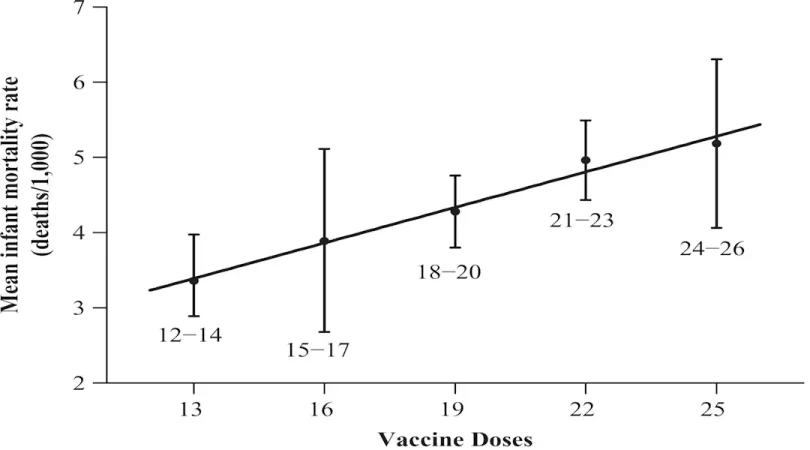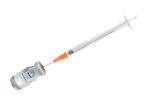Vaccines and sudden infant death: An analysis of the VAERS database 1990–2019 and review of the medical literature
Neil Z. Miller
Abstract:
Although there is considerable evidence that a subset of infants has an increased risk of sudden death after receiving vaccines, health authorities eliminated “prophylactic vaccination” as an official cause of death, so medical examiners are compelled to misclassify and conceal vaccine-related fatalities under alternate cause-of-death classifications. In this paper, the Vaccine Adverse Event Reporting System (VAERS) database was analyzed to ascertain the onset interval of infant deaths post-vaccination. Of 2605 infant deaths reported to VAERS from 1990 through 2019, 58 % clustered within 3 days post-vaccination and 78.3 % occurred within 7 days post-vaccination, confirming that infant deaths tend to occur in temporal proximity to vaccine administration. The excess of deaths during these early post-vaccination periods was statistically significant (p < 0.00001). A review of the medical literature substantiates a link between vaccines and sudden unexplained infant deaths. Several theories regarding the pathogenic mechanism behind these fatal events have been proposed, including the role of inflammatory cytokines as neuromodulators in the infant medulla preceding an abnormal response to the accumulation of carbon dioxide; fatal disorganization of respiratory control induced by adjuvants that cross the blood-brain barrier; and biochemical or synergistic toxicity due to multiple vaccines administered concurrently. While the findings in this paper are not proof of an association between infant vaccines and infant deaths, they are highly suggestive of a causal relationship.
1.1. International classification of diseases
There are 130 official ways for an infant to die. These official categories of death, sanctioned by the World Health Organization (WHO) and Centers for Disease Control and Prevention (CDC), are published in the International Classification of Diseases (ICD) [[1], [2], [3]]. When a baby dies, coroners must choose from among these 130 categories.
The official causes of death listed in the ICD include nearly every imaginable—and tragic—possibility. In fact, previous versions of the ICD listed “prophylactic inoculation and vaccination” as a separate cause-of-death category, with subcategories for deaths caused by specific vaccines. However, when the ICD was revised in 1979—and in subsequent updates to the ICD—all cause-of-death classifications associated with vaccination were eliminated. Since then, medical certifiers have been unable to list vaccination as an official cause of death because the ICD no longer contains a code for that possibility. This is odd because health authorities are aware that some children will become permanently disabled or die after receiving vaccines—the very reason Congress passed the National Childhood Vaccine Injury Act of 1986 (Public Law 99-660), which created the Vaccine Adverse Event Reporting System (VAERS) and established the National Vaccine Injury Compensation Program (VICP).
Many parents don’t realize that when they purchase vaccines, the cost is taxed and the money (75 cents per vaccine) goes into a trust fund managed by the Department of the Treasury to compensate them if and when those vaccines seriously injure or kill their babies. As of May 1, 2021, more than $4.5 billion was granted for thousands of injuries and deaths associated with vaccines. Numerous cases are still pending. Awards were issued for permanent injuries such as learning disabilities, seizure disorders, mental retardation, paralysis, and numerous deaths, including many that were initially misclassified as sudden infant death syndrome (SIDS) [4].
Since vaccine-related deaths are officially recognized by the federal government through the VICP but there are no official classifications for vaccine-related deaths in the ICD, an important question must be asked: What options are available to medical examiners for recording vaccine-related deaths?
1.2. Sudden Infant Death Syndrome (SIDS)
Prior to the introduction of organized vaccination programs, “crib death” was so rare that it was not mentioned in infant mortality statistics. In the United States, national immunization campaigns were expanded in the 1960s when several new vaccines were introduced and promoted. For the first time in history, most U.S. infants were required to receive several doses of DPT (diphtheria, pertussis, tetanus), polio, and measles vaccines. (The measles vaccine was administered at 9 months of age from 1963 to 1965 [5]). Mumps and rubella vaccines were also introduced in the 1960s. By 1969, an alarming epidemic of sudden unexplained infant deaths impelled researchers to create a new medical term—sudden infant death syndrome (SIDS) [6]. By 1972, SIDS had become the leading cause of post-neonatal mortality (infant deaths occurring between 28 days and 1 year of life) in the United States [7]. In 1973, the National Center for Health Statistics, operated by the CDC, created a new cause-of-death category to document deaths due to SIDS [8,9].
https://www.ncbi.nlm.nih.gov/pmc/articles/PMC8255173/
The CDC claims:
Multiple research studies and safety reviews have looked at possible links between vaccines and SIDS. The evidence accumulated over many years do not show any links between childhood immunization and SIDS.
https://www.cdc.gov/vaccinesafety/concerns/sids.html
A study that was published in 2011 in a scientific journal by Neil Z. Miller and Gary S. Goldman concluded that in nations where there was an increase in vaccinations, there was also an increase in the occurrence of SIDS. The graph below shows that as the jab rate increases, infant mortality also rises. [1]
The authors point out in their concluding remarks that before the widespread practice of infant vaccination in the U.S. during the 1960s, SIDS was virtually unheard of, but by the 1980s was the number one leading cause of infant mortality (from 28 days after birth up to one year). They write:

“Prior to contemporary vaccination programs, ‘Crib death’ was so infrequent that it was not mentioned in infant mortality statistics. In the United States, national immunization campaigns were initiated in the 1960s when several new jjabs were introduced and actively recommended. For the first time in history, most US infants were required to receive several doses of DPT, polio, measles, mumps, and rubella jjabs.
Shortly thereafter, in 1969, medical certifiers presented a new medical term — sudden infant death syndrome. In 1973, the National Center for Health Statistics added a new cause-of-death category — for SIDS — to the ICD. SIDS is defined as the sudden and unexpected death of an infant which remains unexplained after a thorough investigation. Although there are no specific symptoms associated with SIDS, an autopsy often reveals congestion and edema of the lungs and inflammatory changes in the respiratory system.”
In order to address the unacceptable high rates of infant mortality due to SIDS, the American Academy of Pediatrics started a campaign called “Back to Sleep” in order to instruct parents to make sure that their infants slept on their backs, promoting the belief still in force today that a major cause of SIDS can be attributed to placing an infant on her stomach (in the prone position), rather than supine (on her back). As a result, the number of cases reported as SIDS decreased dramatically by 8.6%.
Changing Terminology and Reclassifying Incidents
The drop in SIDS rates would seem to indicate that, given other possible factors, at least in terms of unexplained fatalities due to SIDS, sleep position rather than vaccination plays a major role.
The problem, however, is more complex than that and has to do with the way infant deaths were classified in the period from 1990-2001. The number of reported Sudden Unexpected Infant Deaths (SUID) due to “suffocation”, for example, increased by almost 12% during the same period. As Miller and Goldman point out, during the period of decline in reported deaths due to SIDS in the 1990s, there was not only an increase in unclassified deaths or those attributed to “unknown causes” as well as those attributed to suffocation or Shaken Baby Syndrome, but there was also no significant change in the mortality rate for infants ranging from age 28 days through 1 year.
The term SIDS itself, which did not appear until after vaccination programs were in full swing in the United States, has its own questionable history.
In the preface to Neil Z. Miller’s book, Vaccine Safety Manual, [2] Russell Blaylock, M.D. writes:
“A more blatant example of this reclassification ploy is the label of sudden infant death syndrome (SIDS). As Neil Miller’s book demonstrates, 70 percent of SIDS cases have been shown to follow pertussis vaccination within three weeks. A number of the new jjabs are also associated with sudden infant death. In order to avoid admitting that the sudden stoppage of breathing by a baby within hours to weeks of these jjabs was due to the jjabs, the jjab defender merely created a new disease and gave it the incredible name of sudden infant death syndrome, which is like naming it the ‘Baby Mysteriously Die of Anything but a Vaccine Injury Syndrome’ (BMDAVIS).”
What Causes Sudden Infant Death Syndrome?
Based on what we know about SIDS, which is a general term that seems to be used by some in order to evade the possibility that jjabs are at least one cause of infant mortality, there are likely many causes. Some of them may even work together, such as the toxic gases that are produced in reused mattresses, or in mattresses that have been treated with flame retardants.
Research shows that infants who have been vaccinated increase in body temperature, which can elevate and increase the production of toxicity, which in turn effects the infant’s ability to breathe normally. Fevers that result from jjabs can also deplete the presence of Vitamin C, as well as damage the child’s immune system and nervous system. [3]
Dr. Robert S. Mendelsohn, M.D., suspects that “the nearly 10,000 SIDS deaths that occur in the United States each year are related to one or more of the jjabs that are routinely given children. The pertussis jjab is the most likely villain, but it could also be one or more of the others.” (Source)
In the United States, the courts have confirmed such suspicions to the tune of at least $60 Million dollars during the period in which incidents of SIDS were reportedly decreasing (1990-1998).
“The computer records from the National Vaccine Injury Compensation Program, obtained by Gannett News Service using the Freedom of Information Act as part of a four-month study of federal immunization policy, reveal: Of 253 infant death cases awarded more than $61 million by the U.S. Court of Federal Claims in the 1990s under the compensation program, 224, or 86 percent, were attributed to vaccination with DTP, the diphtheria, tetanus and pertussis (whooping cough) shot.
In these cases, mortality was originally attributed to SIDS in 90, or 40 percent, of them. Of 771 total claims filed by parents from 1990 through mid-1998, 660, or 86 percent, contained assertions that DTP was the cause of death. And 43 percent were classified by medical authorities at time of death as SIDS cases.” [4]
Source: https://humansbefree.com/2013/10/vaccines-linked-to-sudden-infant-death-syndrome-sids-evidence.html
Here is another source and graph:
In 2011, we published a study that found a counterintuitive, positive correlation, r = 0.70 (p < .0001), demonstrating that among the most highly developed nations (n = 30), those that require more vaccines for their infants tend to have higher infant mortality rates (IMRs)….

…
In our study of the top 30 nations in 2009, IMR increased by a factor of 0.15 deaths/1,000 live births for each vaccine dose added to the immunization schedule.
Source: https://www.cureus.com/articles/134233-reaffirming-a-positive-correlation-between-number-of-vaccine-doses-and-infant-mortality-rates-a-response-to-critics#!
This is a very comprehensive study and report. If you have an ability to puzzle a few statistics, it is worth a read.







